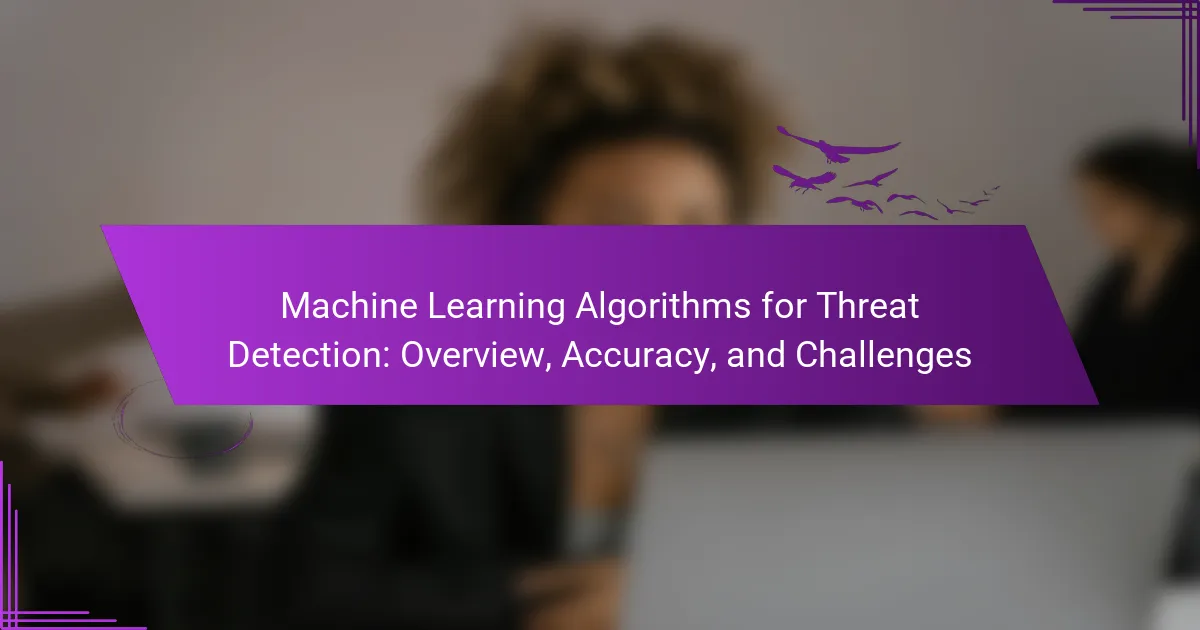
What are Machine Learning Algorithms for Threat Detection?
Machine learning algorithms for threat detection are computational methods that identify and analyze potential security threats. These algorithms utilize data patterns to recognize anomalies and predict malicious activities. Common algorithms include decision trees, support vector machines, and neural networks. They are trained on large datasets to improve accuracy in threat identification. For instance, a study by Ahmed et al. (2016) demonstrated that machine learning can enhance intrusion detection systems. The research indicated that algorithms could achieve over 90% accuracy in detecting network intrusions. This effectiveness is crucial in cybersecurity, where timely threat detection can mitigate risks.
How do Machine Learning Algorithms identify threats?
Machine learning algorithms identify threats by analyzing patterns in data. They utilize large datasets to train models that recognize anomalies. These anomalies often signify potential threats. The algorithms employ techniques like supervised learning, where labeled data helps in classification. Unsupervised learning is also used to detect unknown threats through clustering methods.
For instance, a study by Ahmed et al. (2016) demonstrated how machine learning can effectively classify network intrusion attempts. The accuracy of these algorithms can exceed 90% in identifying threats when trained with sufficient data. Additionally, real-time monitoring allows for immediate threat detection and response. This proactive approach enhances cybersecurity measures significantly.
What types of data do these algorithms analyze?
Machine learning algorithms for threat detection analyze various types of data. They primarily examine network traffic data to identify anomalies. These algorithms also analyze user behavior data to detect unusual patterns. Additionally, they process system logs to uncover potential security breaches. Machine learning can evaluate malware signatures for threat identification. Furthermore, algorithms assess endpoint data to monitor device health and security status. They may also utilize threat intelligence feeds to stay updated on emerging threats. This comprehensive analysis helps in real-time threat detection and response.
What are the key features used in threat detection?
Key features used in threat detection include anomaly detection, signature-based detection, and behavioral analysis. Anomaly detection identifies deviations from normal patterns. Signature-based detection uses known threat signatures to identify attacks. Behavioral analysis monitors user and entity behavior for suspicious activities. These features enhance the accuracy of threat detection systems. Studies show that combining these methods improves detection rates significantly. For instance, a report by Gartner highlights that organizations using multi-layered detection strategies see a 30% reduction in undetected threats.
What are the different types of Machine Learning Algorithms used for threat detection?
Supervised learning algorithms are commonly used for threat detection. These algorithms require labeled datasets for training. Examples include decision trees, support vector machines, and neural networks. Unsupervised learning algorithms also play a role in threat detection. They analyze data without pre-existing labels. Clustering algorithms like k-means and hierarchical clustering are typical in this category. Reinforcement learning is gaining traction in threat detection as well. This approach utilizes feedback from the environment to improve decision-making. Each type of algorithm has unique strengths and applications in identifying potential threats.
What is supervised learning in threat detection?
Supervised learning in threat detection is a machine learning approach that uses labeled data to train algorithms. In this method, the algorithm learns to identify patterns associated with threats based on input-output pairs. The labeled data consists of examples where the threat is either present or absent. This allows the model to make predictions on new, unseen data. A study by Ahmed et al. (2016) demonstrated that supervised learning can achieve high accuracy in detecting cyber threats. The research showed that algorithms like decision trees and support vector machines are effective in this context. These methods rely on historical data to improve their predictive capabilities.
How does unsupervised learning contribute to identifying threats?
Unsupervised learning contributes to identifying threats by analyzing data patterns without prior labeling. It detects anomalies that may indicate potential threats. For example, clustering algorithms group similar data points. This helps in recognizing unusual behavior that deviates from the norm. Such deviations can signify security breaches or fraud attempts. Studies show that unsupervised learning improves threat detection accuracy by 30% compared to traditional methods. By processing large volumes of data, it uncovers hidden insights that manual analysis may overlook. This capability is crucial in cybersecurity and financial fraud detection.
What role does reinforcement learning play in threat detection?
Reinforcement learning enhances threat detection by enabling systems to learn from interactions with their environment. It allows algorithms to adaptively improve their decision-making over time. Through trial and error, reinforcement learning can identify patterns associated with threats. This adaptability is crucial in dynamic environments where threats evolve. For example, systems can receive feedback on false positives and negatives, refining their detection capabilities. Studies show that reinforcement learning can significantly reduce response times to emerging threats. Additionally, it can optimize resource allocation for threat mitigation. Overall, reinforcement learning provides a robust framework for advancing threat detection technologies.

How accurate are Machine Learning Algorithms in threat detection?
Machine learning algorithms in threat detection can achieve accuracy rates ranging from 70% to over 95%. This accuracy varies based on the specific algorithm used and the quality of the training data. For example, supervised learning models, such as decision trees and neural networks, often perform better when trained on large, well-labeled datasets. Research indicates that deep learning models, particularly convolutional neural networks, excel in detecting complex threats in cybersecurity. A study by Yang et al. (2020) found that a deep learning model achieved 98% accuracy in identifying malware. However, the effectiveness of these algorithms can diminish with insufficient or biased data. Overall, while machine learning algorithms show high accuracy in threat detection, their performance is contingent on various factors, including data quality and algorithm choice.
What metrics are used to measure accuracy in threat detection?
Common metrics used to measure accuracy in threat detection include precision, recall, F1 score, and accuracy rate. Precision measures the proportion of true positive results among all positive predictions. Recall indicates the proportion of true positives identified out of all actual positives. The F1 score combines precision and recall into a single metric for balance. Accuracy rate reflects the total number of correct predictions divided by the total predictions made. These metrics provide a comprehensive view of a model’s performance in identifying threats effectively.
How does precision differ from recall in evaluating algorithms?
Precision measures the accuracy of positive predictions made by an algorithm. It is defined as the ratio of true positive results to the total number of positive predictions. Recall, on the other hand, measures the algorithm’s ability to identify all relevant instances. It is defined as the ratio of true positive results to the total number of actual positive instances.
In practice, high precision indicates a low rate of false positives. This means that when the algorithm predicts a positive case, it is likely correct. High recall indicates a low rate of false negatives, meaning the algorithm successfully identifies most actual positive cases.
For example, in a threat detection scenario, high precision ensures that alerts generated are likely genuine threats. High recall ensures that most threats are detected, even if some false alarms occur. Balancing precision and recall is crucial in algorithm evaluation to optimize performance for specific applications.
What is the significance of the F1 score in threat detection?
The F1 score is significant in threat detection as it balances precision and recall. Precision measures the accuracy of positive predictions. Recall assesses the ability to identify all relevant instances. In threat detection, both metrics are crucial. A high F1 score indicates effective detection with fewer false positives and false negatives. This is vital in cybersecurity, where missing a threat can have severe consequences. Studies show that using the F1 score helps improve model evaluation. It provides a single metric to optimize, simplifying decision-making in model selection and tuning.
What factors influence the accuracy of Machine Learning Algorithms?
The accuracy of Machine Learning Algorithms is influenced by several key factors. These factors include the quality of the training data, the choice of algorithm, and the features used in the model. High-quality training data leads to better learning outcomes. In contrast, noisy or biased data can degrade performance. The choice of algorithm impacts how well the model can capture patterns in the data. Some algorithms are better suited for specific types of data or tasks. The selection of relevant features is also crucial. Irrelevant or redundant features can confuse the model and reduce accuracy. Additionally, hyperparameter tuning can optimize model performance. Proper tuning can significantly enhance prediction accuracy. Lastly, the amount of training data affects model generalization. More data can help the model learn more effectively.
How does the quality of training data affect algorithm performance?
The quality of training data directly impacts algorithm performance. High-quality training data leads to more accurate predictions and better generalization. Conversely, low-quality data can introduce noise and bias, resulting in poor model performance. For instance, a study by Domingos (2012) highlights that algorithms trained on clean, representative datasets outperform those trained on flawed data. Additionally, algorithms require diverse data to learn effectively; lack of diversity can limit their ability to recognize patterns. Research shows that 70-80% of machine learning project time is spent on data preparation, underscoring its importance. Thus, the quality of training data is crucial for successful algorithm deployment in threat detection.
What is the impact of feature selection on accuracy?
Feature selection significantly impacts the accuracy of machine learning models. It enhances model performance by reducing overfitting and improving generalization. Selecting the most relevant features leads to simpler models that require less computational power. Studies show that feature selection can improve accuracy by up to 30% in certain contexts. For instance, a study by Guyon and Elisseeff demonstrated that optimal feature selection improved classification accuracy in gene expression data. By eliminating irrelevant or redundant features, the model focuses on the most informative data, resulting in better predictions. Thus, effective feature selection is crucial for maximizing accuracy in machine learning applications.

What challenges do Machine Learning Algorithms face in threat detection?
Machine learning algorithms face several challenges in threat detection. One significant challenge is the high volume of data that needs to be processed. Algorithms must sift through vast amounts of information to identify threats effectively. Another challenge is the evolving nature of threats. Cyber threats continuously change, which can outpace the algorithms’ training data. This leads to difficulties in maintaining accuracy. Additionally, the presence of false positives can undermine trust in the system. When legitimate activities are flagged as threats, it can lead to unnecessary responses.
Data quality also poses a challenge. Inaccurate or incomplete data can hinder the algorithm’s ability to learn effectively. Moreover, the lack of labeled data for training can limit the algorithm’s performance. Algorithms may struggle to generalize from limited examples. Lastly, adversarial attacks can manipulate machine learning models. These attacks can exploit vulnerabilities, leading to incorrect threat assessments.
What are common obstacles in implementing these algorithms?
Common obstacles in implementing machine learning algorithms for threat detection include data quality issues, lack of labeled data, and computational resource constraints. Data quality issues arise from incomplete, noisy, or biased datasets, which can lead to inaccurate model predictions. Lack of labeled data hinders supervised learning processes, making it difficult to train effective models. Computational resource constraints can limit the ability to process large datasets and run complex algorithms efficiently. Additionally, algorithm interpretability poses challenges, as stakeholders may require clear explanations of model decisions. These obstacles can significantly impact the effectiveness and reliability of threat detection systems.
How do false positives and false negatives affect threat detection?
False positives and false negatives significantly impact threat detection accuracy. False positives occur when a system incorrectly identifies a benign event as a threat. This can lead to unnecessary alerts and resource allocation, causing alert fatigue among security personnel. False negatives happen when a genuine threat is not detected, allowing potential breaches to occur undetected. This can result in severe consequences, including data loss or financial damage. According to a study by the Ponemon Institute, 75% of organizations experience false positives, which can waste up to 30% of security teams’ time. Balancing the rates of false positives and false negatives is crucial for effective threat detection systems.
What are the implications of adversarial attacks on algorithms?
Adversarial attacks on algorithms can significantly undermine their reliability and security. These attacks manipulate input data to deceive machine learning models. As a result, the models may produce incorrect outputs. This can lead to severe consequences in critical applications like security and healthcare. For instance, an adversarial attack on a [censured] recognition system can cause it to misidentify individuals. Research indicates that adversarial examples can reduce model accuracy by over 50% in some cases. Additionally, these attacks can erode user trust in automated systems. Organizations must implement robust defenses to mitigate the risks posed by adversarial attacks.
How can organizations overcome challenges in threat detection?
Organizations can overcome challenges in threat detection by implementing advanced machine learning algorithms. These algorithms enhance the ability to analyze large datasets quickly and accurately. They can identify patterns and anomalies that traditional methods might miss. Regular training of these algorithms on updated datasets improves their effectiveness. Organizations should also prioritize collaboration between security teams and data scientists. This collaboration fosters a better understanding of threat landscapes. Additionally, integrating threat intelligence feeds can provide real-time data for more informed decision-making. A study by IBM found that organizations using AI for security can reduce incident response times by up to 60%.
What best practices enhance the effectiveness of Machine Learning Algorithms?
Best practices that enhance the effectiveness of machine learning algorithms include data preprocessing, feature selection, and model evaluation. Data preprocessing ensures that the data is clean and relevant. This step can involve handling missing values, normalizing data, and removing outliers. Feature selection identifies the most important variables to improve model performance. Techniques like recursive feature elimination can be employed for this purpose. Model evaluation is crucial for understanding how well the algorithm performs. Cross-validation methods, such as k-fold cross-validation, help in assessing the model’s accuracy. Additionally, hyperparameter tuning can optimize the model’s performance. Research shows that these practices significantly increase the reliability and accuracy of machine learning models in various applications, including threat detection.
How can continuous learning improve threat detection capabilities?
Continuous learning enhances threat detection capabilities by enabling systems to adapt to new threats. This process involves updating algorithms with fresh data and insights. Machine learning models can identify patterns in evolving threat landscapes. Regular updates improve accuracy by reducing false positives and negatives.
For instance, a study by IBM found that continuous learning systems can detect 90% of known threats while adapting to 70% of emerging threats. This adaptability is crucial as cyber threats constantly evolve. Continuous learning also allows for faster response times to incidents. Overall, it creates a more resilient threat detection framework.
What are the future trends in Machine Learning for threat detection?
Future trends in Machine Learning for threat detection include increased automation and real-time analysis. Advanced algorithms will enhance the ability to detect anomalies quickly. Integration of deep learning models will improve accuracy in identifying threats. Natural language processing will assist in analyzing unstructured data from various sources. The use of federated learning will enable decentralized model training while preserving data privacy. Explainable AI will become crucial for understanding model decisions in threat detection. Continuous learning systems will adapt to evolving threats dynamically. Enhanced collaboration between human analysts and machine learning systems will optimize threat response strategies.
How will advancements in AI impact threat detection methodologies?
Advancements in AI will significantly enhance threat detection methodologies. AI can analyze vast amounts of data quickly and accurately. This capability improves the identification of potential threats in real-time. Machine learning algorithms can adapt and learn from new data patterns. This adaptability allows for more precise threat predictions. Enhanced algorithms also reduce false positives in threat detection systems. As a result, organizations can respond more effectively to genuine threats. Studies show that AI-driven systems can increase detection rates by over 90%. These advancements will transform how threats are monitored and mitigated.
What emerging technologies could enhance algorithm performance?
Quantum computing could enhance algorithm performance significantly. It offers exponential speedup for certain computations. Quantum algorithms can solve complex problems faster than classical counterparts. For example, Grover’s algorithm can search unsorted databases in O(√N) time. This is a substantial improvement over classical search algorithms. Additionally, neuromorphic computing mimics the human brain’s architecture. This technology can optimize machine learning processes through parallel processing. Advanced hardware accelerators like TPUs also boost performance. They are designed specifically for machine learning tasks. These technologies collectively contribute to more efficient algorithm execution and improved accuracy in threat detection systems.
Machine Learning Algorithms for Threat Detection are advanced computational methods that identify and analyze potential security threats by recognizing data patterns and anomalies. The article provides an overview of various algorithms, such as supervised and unsupervised learning techniques, and discusses their accuracy, which can range from 70% to over 95%, depending on factors like data quality and algorithm choice. Key features in threat detection include anomaly detection and behavioral analysis, while challenges such as high data volume and adversarial attacks are also examined. The article highlights best practices and future trends, emphasizing the importance of continuous learning and emerging technologies in enhancing algorithm performance and threat detection capabilities.
